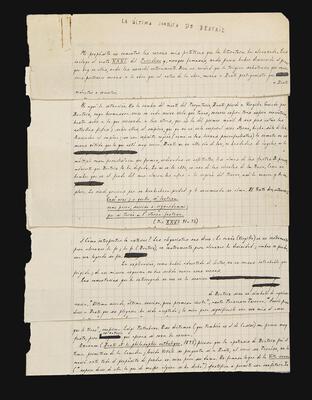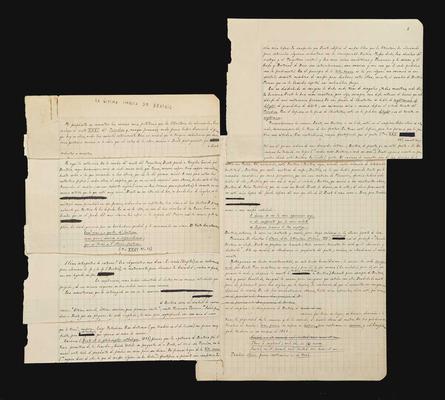Jorge Luis Borges
La última sonrisa de Beatriz.
Autograph manuscript. Buenos Aires, ca.1948.Six pieces of paper, of varying sizes, detached from an autograph square-ruled notebook (one entire leaf andfive cuttings). Complete. I. 57x166 mm, heading and 6 lines; II. 106x166 mm, 16 lines; III. 76x166 mm, 10 lines;IV. 56x166 mm, 6 lines; V. 123x166 mm, 20 lines; VI. 213x166 mm, 34 lines. The verso of all six pieces of paper blank. Text written in blue ink; the foliation is also in Borges's hand. Numerous corrections, some words andphrases deleted in ink. Traces of a paper clip on the upper margin of the first slip.
Provenance: Livio Ambrogio collection.
The original autograph text, with numerous corrections and crossings-out, of the essay La última sonrisa de Beatriz (Beatrice's Last Smile), from one of the square-ruled notebooks which Borges commonly used to draft his literary works and articles. The first slip of paper bears, in his neat and regular handwriting, the title of the essay, in which the Argentinian writer comments on the verses of the Paradiso describing Beatrice smiling to Dante from one of the circles of the mystical rose, and then turning away forever (Paradiso,XXXI91-93):
Così orai; e quella, sí lontana
Come parea, sorrise, et riguardommi;
Poi si tornò a l'eterna fontana.
Borges declares that these are “los versos más patéticos que la literatura ha alcanzado” (“the most moving lines literature has achieved”), symbolising the spiritual beauty of Beatrice, Dante's lost love. The essay was composed around 1948 and first published only in 1982 in the collection Nueve ensayos dantescos; the corrections, changes and characteristic crossings-out visible in this draft reveal the meticulous revision that the text underwent. Borges began to read the Commedia systematically in the late 1930s, on his daily tram journey to the National Library in Buenos Aires, where he was employed. The inexhaustible textual imagery of Dante's poem fascinated him. The collection of essays Siete noches (1980) opens with a chapter on the Commedia, and echoes of this reading can be found in his literary writings: in El Aleph (1949), one of Borges's most celebrated stories, the figure of the beloved Beatriz Viterbo is clearly inspired by Dante's muse, the forever unreachable Beatrice Portinari. The present manuscript provides significant autograph evidence for Borges's methods of working and, as an evidently late draft of the essay, his final revisions of his most famous tribute to Dante.



